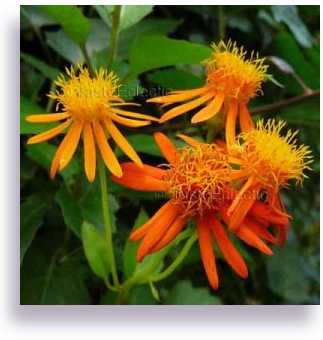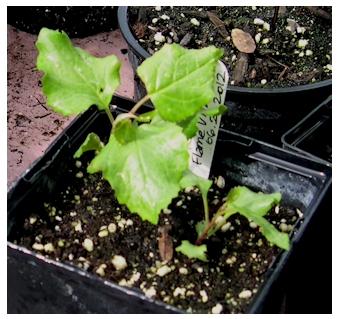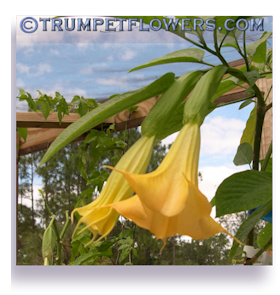
Pronunciation: sen-NEESH-shee-oh kun-FEW-sus
The Mexican Flame vine, or scientifically known as either Senecio confusus (older name) or more recently called Pseudogynoxys chenopodiodes, is a tender vine that grows well in zones 8B through 11. As it's common name suggests, it is a native of Mexico, but thrives in south Florida climes. Mexican Flame vine is grown not only for it's apparent beauty, but also the nectar rich flowers that attract many southern Florida butterflies and of course, honeybees.Easy to propagate from fresh seed, Mexican Flame vine grows quickly after it's first month. The seeds are tiny, so getting them up and going can be a task. When they finally show true leaves (about two weeks to a month in) they will begin to take off and soon need some kind of support.
 Do not fertilize the plant for the first two months if growing from seed. Let the Osmocote you put in the seedling mix do that instead. After it is hardened off, begin fertilizing it once every six months at half strength the first year. If you live further north, it will have to come in for the winter or be grown as an annual. In zone 8B and 9, mulch the base heavily with pine straw or melaluccea chips, and wait for spring. In zones 10 and beyond, the plant will stay evergreen.
Do not fertilize the plant for the first two months if growing from seed. Let the Osmocote you put in the seedling mix do that instead. After it is hardened off, begin fertilizing it once every six months at half strength the first year. If you live further north, it will have to come in for the winter or be grown as an annual. In zone 8B and 9, mulch the base heavily with pine straw or melaluccea chips, and wait for spring. In zones 10 and beyond, the plant will stay evergreen.
The plant can grow to an enormous size in the south, so give it a good sturdy fence or trellis to grow on. It prefers full sun, but protect it from the hottest part of the day with dappled sunlight if possible. The leaves can sunburn. Keep the soil slightly moist when the rains have ceased for over 3 days. It will establish itself fully within a year to a year and a half. After it has been planted out in the landscape, fertilize it in spring with a fruit and nut tree spike driven into the ground at it's base.
Mexican Flame Vine does not have tendrils, but it will easily wind itself around the support that you give it without them. If you give it no support, it will quickly cover a ground area, covered with hundreds of the bright orange flowers. This may not be such a good idea, as ultimately grass and weeds will grow up through the plant.
We have found that pruning it slightly, plus deadheading old flowers, helps to keep the flowers in view. If we allow the plant to just go crazy (which it will) then most of the flowers can be out of your line of sight, hiding amongst the greenery at the very top of the vines.
Mexican Flame vine is also easy to propagate by stem cuttings at the node, or you can just slightly bury a few of the stems that are near the ground with a handful of tamped soil. They will sprout roots there, and within 6 weeks you can cut them loose from the mother plant, and start some new ones.
Know that this plant will make roots anywhere the vine touches the ground, so this is also an easy propagation method. Just place some of the longer vines on the ground and wait a couple of months, then cut them loose from the mother stem and you'll have new babies to pot up or place out in new garden areas. Because of this, it can be invasive, especially in frost free zones.
If you are having trouble getting your Mexicn Flame Vine to flower, it may be that you are over fertilizing it. Cut back on the fertilizer, and only water it when it wilts. Mexican Flame vine is a native to desert conditions, so trying to duplicate those circumstances can help bring on blooms.
Mexican Flame vines are perfect to add to a stone wall, privacy fence, or the base of a palm tree. We are going to grow our seedlings shown above out on an arbor that is currently being built, and I will have some lovely pictures of it to show you in spring or summer of 2013.
Tags: mexican flame vine, Senecio confusus, Pseudogynoxys chenopodioides, how to grow mexican flame vine, care of mexican flame vine, propagate mexican flame vine,


